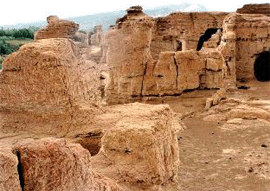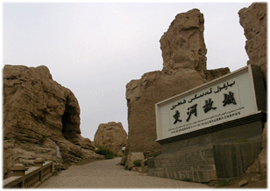The Jiaohe Ruins is the only earthen architecture town that is the largest, the oldest and the best protected in the world. It is also the most complete ruins of an ancient capital having been protected for more than 2,000 years in China and was once the site of the Anxi Protectorate, the supreme military and government organization of the Western Regions in the Tang Dynasty. Almost all parts of the  Jiaohe Ruins were created by digging the earth and the tallest building was three levels high. After having been exposed to the sun and rains for 2,300 years, the Jiaohe Ruins still stands lofty there. Jiaohe Ruins were created by digging the earth and the tallest building was three levels high. After having been exposed to the sun and rains for 2,300 years, the Jiaohe Ruins still stands lofty there.
Located at a 30-meter-high cliff platform of the Ya'ernaizi Gouge, which is 10 kilometers west of Turpan city, the Jiaohe Ruins takes the shape of a willow-leaf peninsula and has a length of 1,650 meters and a maximum width of 300 meters. Jiaohe (two rivers joining together) got its name due to two rivers joined together at the southern part of the town in ancient times.
The landform of the Jiaohe Ruins is narrow and long, and from northwest to southeast, it is 1,760 meters long. With a maximum width of 300 meters, The Jiaohe Ruins occupies a total area of 430,000 square meters, of which 360,000 square meters are construction areas. The construction areas, mainly in the southeastern part of the ruins, make up two thirds of the total area of the ruins. Due to river water erosion, bluffs as high as several dozens meters are formed around the cliff platform and therefore, Jiaohe was a place of strategic importance since ancient times due to its steepness and the advantages of being easy to defend and difficult to attack.
The Jiaohe Ruins was a famous historic town along the "Silk Road" and was active for at least 1,500 years on the stage of history. Although with different political status in various dynasties, Jiaohe was always one of the centers of politics, military and farmland cultivation in the Western Regions of ancient times. It once played a very important role in promoting the cultural exchanges between the east and the west in history. The Jiaohe Ruins is a historic monument of the development and construction by different nationalities in ancient times.
After having experienced all kinds of changes and erosion by wind and rains for more than 2,000 years, the main structure of the architecture layout of the Jiaohe Ruins is still well preserved till the present  day, which is really a miracle. This is mainly due to the dry weather in the Turpan region. The current scale of the Jiaohe Ruins is mainly the architecture of the Tang Dynasty and architectures are mainly located in the area of about 1,000 meters in the southeast part of the platform. Surrounded by high cliffs in four sides, three towns were built on the high cliffs of east, west and south sides. day, which is really a miracle. This is mainly due to the dry weather in the Turpan region. The current scale of the Jiaohe Ruins is mainly the architecture of the Tang Dynasty and architectures are mainly located in the area of about 1,000 meters in the southeast part of the platform. Surrounded by high cliffs in four sides, three towns were built on the high cliffs of east, west and south sides.
The architecture layout of the Jiaohe Ruins comprises three parts: one south-north central road running through the city divided the town into two parts. At the northern end of the road there was a temple with a magnificent scale and the construction area in the temple area was about 90,000 square meters. The architectures were mainly rectangular-shaped courtyards, with their doors facing the central road. The plain arrangement of each of the courtyards indicates it was a temple, and the square earthen pole in the main room, which might by an altar or pagoda pole, proves this. In the southeastern section of the east part was a large residential area, with construction space of about 78,000 square meters; the northern part was a small-scale residential area while the middle part was the sites of government and military organizations. Majority of the west part was residential area and in addition, there were also handicraft workshops. At the two sides of the central road were high and thick street walls with no windows. The south-north and east-west streets and lanes divided the town into a number of small areas, which were typical arrangements of ancient towns in China. |
